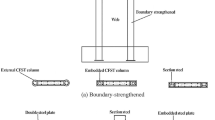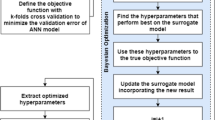Abstract
Accurate prediction of the ultimate shear capacity of reinforced concrete shear walls (RCSWs) is essential for robust design of buildings under seismic and wind loads. However, the shear capacity of RCSWs depends on multiple complex design variables characterized by diverse geometric and materials properties. Thus, a powerful modeling framework is required. In this paper, a hybrid artificial intelligence model is proposed for predicting the ultimate shear capacity of RCSWs named artificial neural network (ANN) coupled with adaptive harmony search optimization (AHS) algorithm. Different statistical metrics were used to compare the performances of the ANN model coupled with AHS (ANN-AHS) to three existing empirical relations and two ANN models combined with harmony search (ANN-HS) and global-best harmony search (ANN-GHS). Results show that the proposed ANN-AHS achieved superior performance in modelling the shear strength of RCSWs compared to ANN-HS and ANN-GHS models. The soft-computing models have proven to be more accurate than existing empirical relations.










Similar content being viewed by others
Explore related subjects
Discover the latest articles, news and stories from top researchers in related subjects.References
Fintel M (1991) Shearwalls—an answer for seismic resistance? Concr Int 13(7):48–53
Darwin D, Dolan CW, Nilson AH (2016) Design of concrete structures. McGraw-Hill Education, New York
ACI Committee 318 (2019)Committee A Building code requirements for structural concrete (318M-19) and commentary
Code P (2005) Eurocode 8: Design of structures for earthquake resistance-part 1: general rules, seismic actions and rules for buildings. European Committee for Standardization, Brussels
Teng S, Chandra J (2016) Cyclic shear behavior of high strength concrete structural walls. Petra Christian University, Surabaya
Chandra J, Chanthabouala K, Teng S (2018) Truss model for shear strength of structural concrete walls. ACI Struct J 115(2):323–335
Lu Y, Henry RS (2017) Numerical modelling of reinforced concrete walls with minimum vertical reinforcement. Eng Struct 143:330–345. https://doi.org/10.1016/j.engstruct.2017.02.043
Mazars J, Kotronis P, Davenne L (2002) A new modelling strategy for the behaviour of shear walls under dynamic loading. Earthq Eng Struct Dyn 31(4):937–954. https://doi.org/10.1002/eqe.131
Farvashany FE (2017) Parametric studies on reinforced concrete shear walls: an engineering response to Einstein’s riddle? ACI Struct J 114(5):1099–1108
Baghi H, Baghi H, Siavashi S (2019) Novel empirical expression to predict shear strength of reinforced concrete walls based on particle swarm optimization. ACI Struct J 116(5):247–260
Shahriar A, Nehdi M (2013) Modeling rheological properties of oil well cement slurries using multiple regression analysis and artificial neural networks. Int J Mater Sci 3(1):26–37
Abuodeh OR, Abdalla JA, Hawileh RA (2020) Assessment of compressive strength of ultra-high performance concrete using deep machine learning techniques. Appl Soft Comput 95:106552. https://doi.org/10.1016/j.asoc.2020.106552
Ghaleini EN, Koopialipoor M, Momenzadeh M, Sarafraz ME, Mohamad ET, Gordan B (2019) A combination of artificial bee colony and neural network for approximating the safety factor of retaining walls. Eng Comput 35(2):647–658. https://doi.org/10.1007/s00366-018-0625-3
Al-Musawi AA, Alwanas AAH, Salih SQ, Ali ZH, Tran MT, Yaseen ZM (2020) Shear strength of SFRCB without stirrups simulation: implementation of hybrid artificial intelligence model. Eng Comput 36(1):1–11. https://doi.org/10.1007/s00366-018-0681-8
Zhang G, Ali ZH, Aldlemy MS, Mussa MH, Salih SQ, Hameed MM, Al-Khafaji ZS, Yaseen ZM (2020) Reinforced concrete deep beam shear strength capacity modelling using an integrative bio-inspired algorithm with an artificial intelligence model. Eng Comput. https://doi.org/10.1007/s00366-020-01137-1
Gaspar B, Teixeira A, Soares CG (2017) Adaptive surrogate model with active refinement combining Kriging and a trust region method. Reliab Eng Syst Saf 165:277–291
Xiao M, Zhang J, Gao L (2020) A system active learning Kriging method for system reliability-based design optimization with a multiple response model. Reliab Eng Syst Saf 199:106935. https://doi.org/10.1016/j.ress.2020.106935
Xiao M, Zhang J, Gao L, Lee S, Eshghi AT (2019) An efficient Kriging-based subset simulation method for hybrid reliability analysis under random and interval variables with small failure probability. Struct Multidiscip Optim 59(6):2077–2092
Zhang J, Gao L, Xiao M (2020) A new hybrid reliability-based design optimization method under random and interval uncertainties. Int J Numer Methods Eng. https://doi.org/10.1002/nme.6440
Zhang J, Xiao M, Gao L, Chu S (2019) A combined projection-outline-based active learning Kriging and adaptive importance sampling method for hybrid reliability analysis with small failure probabilities. Comput Methods Appl Mech Eng 344:13–33
Zhang J, Xiao M, Gao L, Fu J (2018) A novel projection outline based active learning method and its combination with Kriging metamodel for hybrid reliability analysis with random and interval variables. Comput Methods Appl Mech Eng 341:32–52
Chojaczyk A, Teixeira A, Neves LC, Cardoso J, Soares CG (2015) Review and application of artificial neural networks models in reliability analysis of steel structures. Struct Saf 52:78–89
Dai H, Zhang H, Wang W (2012) A support vector density-based importance sampling for reliability assessment. Reliab Eng Syst Saf 106:86–93
Xiao M, Gao L, Xiong H, Luo Z (2015) An efficient method for reliability analysis under epistemic uncertainty based on evidence theory and support vector regression. J Eng Des 26(10–12):340–364
Zhang J, Xiao M, Gao L, Chu S (2019) Probability and interval hybrid reliability analysis based on adaptive local approximation of projection outlines using support vector machine. Comput Aided Civ Infrastruct Eng 34(11):991–1009
Fei C-W, Li H, Liu H-T, Lu C, An L-Q, Han L, Zhao Y-J (2020) Enhanced network learning model with intelligent operator for the motion reliability evaluation of flexible mechanism. Aerosp Sci Technol 107:106342. https://doi.org/10.1016/j.ast.2020.106342
Keshtegar B, Meng D, Ben Seghier MEA, Xiao M, Trung N-T, Bui DT (2020) A hybrid sufficient performance measure approach to improve robustness and efficiency of reliability-based design optimization. Eng Comput. https://doi.org/10.1007/s00366-019-00907-w
Keshtegar B, Kisi O (2017) M5 model tree and Monte Carlo simulation for efficient structural reliability analysis. Appl Math Model 48:899–910
Keshtegar B, Bagheri M, Fei C-W, Lu C, Taylan O, Thai D-K (2021) Multi-extremum-modified response basis model for nonlinear response prediction of dynamic turbine blisk. Eng Comput. https://doi.org/10.1007/s00366-020-01273-8
Jiang C, Qiu H, Li X, Chen Z, Gao L, Li P (2020) Iterative reliable design space approach for efficient reliability-based design optimization. Eng Comput 36(1):151–169. https://doi.org/10.1007/s00366-018-00691-z
Gao L, Xiao M, Shao X, Jiang P, Nie L, Qiu H (2012) Analysis of gene expression programming for approximation in engineering design. Struct Multidiscip Optim 46(3):399–413. https://doi.org/10.1007/s00158-012-0767-7
Zhu S-P, Keshtegar B, Chakraborty S, Trung N-T (2020) Novel probabilistic model for searching most probable point in structural reliability analysis. Comput Methods Appl Mech Eng 366:113027. https://doi.org/10.1016/j.cma.2020.113027
Zhang Y, Gao L, Xiao M (2020) Maximizing natural frequencies of inhomogeneous cellular structures by Kriging-assisted multiscale topology optimization. Comput Struct 230:106197
Fei C-W, Lu C, Liem RP (2019) Decomposed-coordinated surrogate modeling strategy for compound function approximation in a turbine-blisk reliability evaluation. Aerosp Sci Technol 95:105466. https://doi.org/10.1016/j.ast.2019.105466
Zhu S-P, Keshtegar B, Tian K, Trung N-T (2021) Optimization of load-carrying hierarchical stiffened shells: comparative survey and applications of six hybrid heuristic models. Arch Comput Methods Eng. https://doi.org/10.1007/s11831-021-09528-3
Yaseen ZM, Keshtegar B, Hwang H-J, Nehdi ML (2019) Predicting reinforcing bar development length using polynomial chaos expansions. Eng Struct 195:524–535. https://doi.org/10.1016/j.engstruct.2019.06.012
Ramadan Suleiman A, Nehdi ML (2017) Modeling self-healing of concrete using hybrid genetic algorithm–artificial neural network. Materials 10(2):135
Omar T, Nehdi M, Zayed T (2017) Integrated condition rating model for reinforced concrete bridge decks. J Perform Constr Facil 31(5):04017090
Hasanipanah M, Keshtegar B, Thai D-K, Troung N-T (2020) An ANN-adaptive dynamical harmony search algorithm to approximate the flyrock resulting from blasting. Eng Comput. https://doi.org/10.1007/s00366-020-01105-9
Jaddi NS, Abdullah S (2017) A cooperative-competitive master-slave global-best harmony search for ANN optimization and water-quality prediction. Appl Soft Comput 51:209–224. https://doi.org/10.1016/j.asoc.2016.12.011
Naik B, Nayak J, Behera HS, Abraham A (2016) A self adaptive harmony search based functional link higher order ANN for non-linear data classification. Neurocomputing 179:69–87. https://doi.org/10.1016/j.neucom.2015.11.051
Song C, Wang Y, Puranam A, Pujol S, 445B AS, Usta M (2015) ACI 445B Shear Wall Database.
Hornik K, Stinchcombe M, White H (1989) Multilayer feedforward networks are universal approximators. Neural Netw 2(5):359–366
Geem ZW, Kim JH, Loganathan G (2002) Harmony search optimization: application to pipe network design. Int J Model Simul 22(2):125–133
Omran MG, Mahdavi M (2008) Global-best harmony search. Appl Math Comput 198(2):643–656
318 AC (2014) Building code requirements for structural concrete (ACI 318-14) and commentary on building code requirements for structural concrete (ACI 318R-14)
Keshtegar B, MeAB S (2018) Modified response surface method basis harmony search to predict the burst pressure of corroded pipelines. Eng Fail Anal 89:177–199
Author information
Authors and Affiliations
Corresponding authors
Rights and permissions
About this article
Cite this article
Keshtegar, B., Nehdi, M.L., Kolahchi, R. et al. Novel hybrid machine leaning model for predicting shear strength of reinforced concrete shear walls. Engineering with Computers 38 (Suppl 5), 3915–3926 (2022). https://doi.org/10.1007/s00366-021-01302-0
Received:
Accepted:
Published:
Issue Date:
DOI: https://doi.org/10.1007/s00366-021-01302-0




